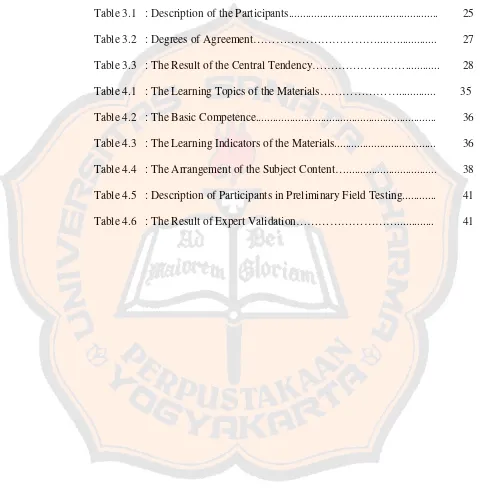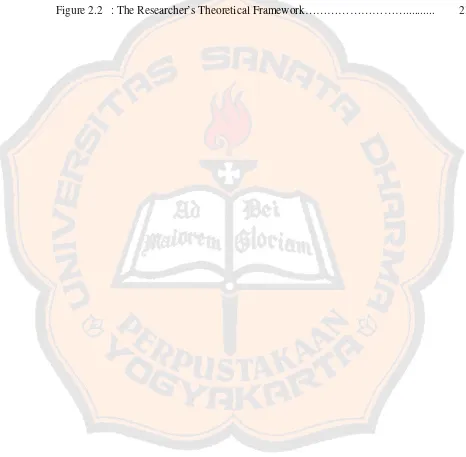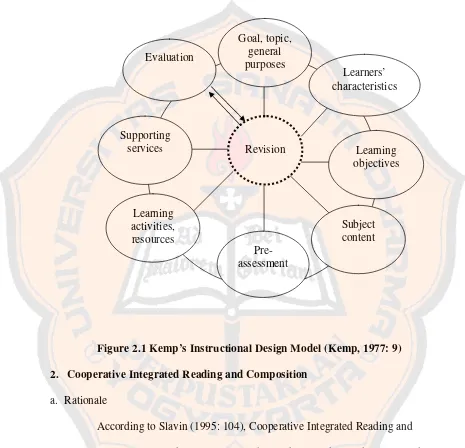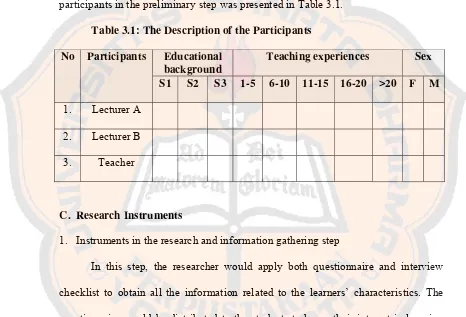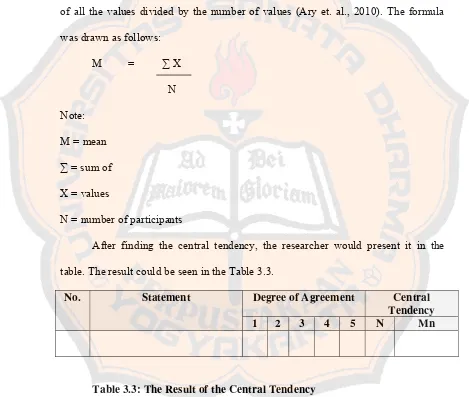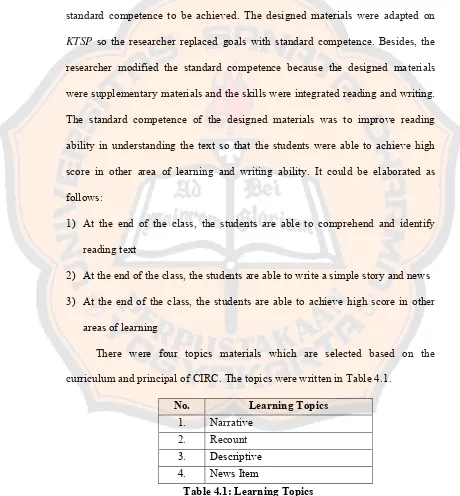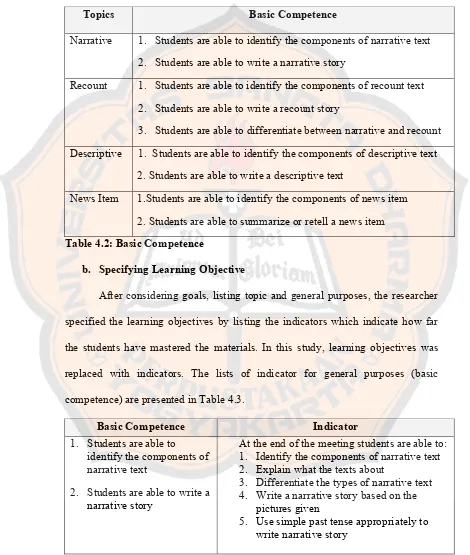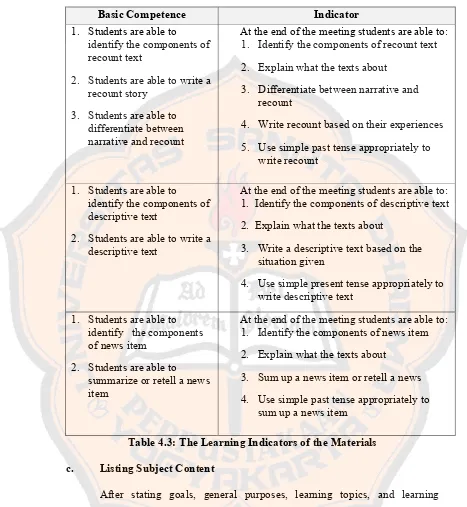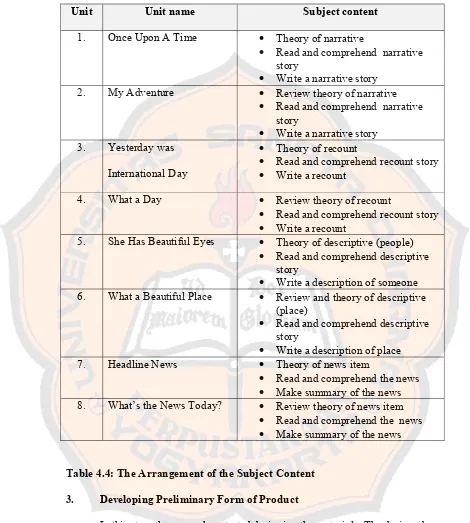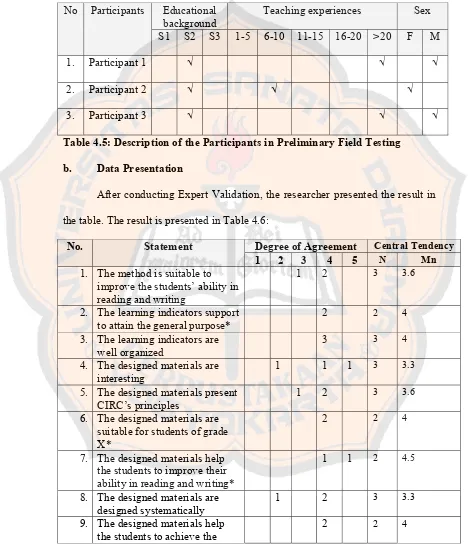READING AND WRITING MATERIALS USING CIRC FOR STUDENTS OF SMA BOPKRI 2 YOGYAKARTA GRADE X
A THESIS
Presented as Partial Fulfillment of the Requirements to Obtain the Sarjana Pendidikan Degree
in English Language Education
By Yurista Pratiwi Student Number: 061214013
ENGLISH LANGUAGE EDUCATION STUDY PROGRAM DEPARTMENT OF LANGUAGE AND ARTS EDUCATION FACULTY OF TEACHERS TRAINING AND EDUCATION
SANATA DHARMA UNIVERSITY YOGYAKARTA
i
READING AND WRITING MATERIALS USING CIRC FOR STUDENTS OF SMA BOPKRI 2 YOGYAKARTA GRADE X
A THESIS
Presented as Partial Fulfillment of the Requirements to Obtain the Sarjana Pendidikan Degree
in English Language Education
By Yurista Pratiwi Student Number: 061214013
ENGLISH LANGUAGE EDUCATION STUDY PROGRAM DEPARTMENT OF LANGUAGE AND ARTS EDUCATION FACULTY OF TEACHERS TRAINING AND EDUCATION
SANATA DHARMA UNIVERSITY YOGYAKARTA
READING
Spon
C. Tutyand
G AND WRI OF SMA
nsor
dari, S.Pd., M
A ITING MAT A BOPKRI 2
Yu Student N
A
M.Pd.
ii A Thesis on
TERIALS U 2 YOGYAK
By urista Pratiw Number: 06 1
Approved by
USING CIR KARTA GR
wi
1214 013
y
17th Se
RC FOR ST RADE X
eptember 20
TUDENTS
iv
Take Time
Take time to think; it is the source of power. Take time to read; it is the foundation of wisdom. Take time to play; it is the secret of staying young. Take time to be quiet; it is the opportunity to seek God. Take time to be aware; it is the opportunity to help others. Take time to love and to be loved; it is God’s greatest gift. Take time to laugh; it is the music of the soul.
Take time to be friendly; it is the road of happiness. Take time to dream; it is what the future is made of. Take time to pray; it is the greatest power on earth.
v
STATEMENT OF WORK’S ORIGINALITY
I honestly declare that this thesis, which I have written, does not contain the work or parts of the work of other people, except those cited in the quotations and references, as a scientific paper should.
Yogyakarta, 3rd October 2011 The writer
Yurista Pratiwi 061214013
vi
LEMBAR PERNYATAAN PERSETUJUAN
PUBLIKASI KARYA ILMIAH UNTUK KEPENTINGAN AKADEMIK
Yang bertanda tangan di bawah ini, saya mahasiswa Universitas Sanata Dharma: Nama : Yurista Pratiwi
Nomor Mahasiswa : 06 1214 013
Demi pengembangan ilmu pengetahuan, saya memberikan kepada Perpustakaan Universitas Sanata Dharma karya ilmiah saya yang berjudul:
READING AND WRITING MATERIALS USING CIRC FOR STUDENTS OF SMA BOPKRI 2 YOGYAKARTA GRADE X.
Dengan demikaian saya memberi kepada Perputakaan Universitas Sanata Dharma hak untuk menyimpan, mengalihkan dalam bentuk media lain, mengelolanya dalam bentuk pangkalan data, mendistribusikan secara terbatas dam mempublikasikan di internet atau media lain untuk kepentingan akademis tanapa perlu meminta izin dari saya maupun memberi royalti kepada saya selama tetap mencantumkan nama saya sebagai penulis.
Demikian pernyataan ini saya buat dengan sebenarnya Dibuat di Yogyakarta
Pada tanggal 3 Oktober 2011 Yang menyatakan
vii
ABSTRACT
Pratiwi, Yurista. 2011. Reading and Writing Materials Using CIRC for Students of SMA BOPKRI 2 Yogyakarta Grade X. Yogyakarta: English Language Education Study Program, Sanata Dharma University.
In this study, the researcher used Cooperative Integrated Reading and Composition (CIRC) as the method in designing the reading and writing materials because CIRC is one of the methods which can improve reading and writing skill through its activities. The researcher believes that by integrating reading and writing using CIRC can help students to understand what they have read and learned.
This study was aimed to develop reading and writing materials by designing the materials using CIRC for senior high school grade X. The study answered two problems:1) how reading and writing materials using Cooperative Integrated Reading and Composition (CIRC) to teach reading for senior high school students are designed, and 2) what the designed materials look like.
To develop the materials, the researcher adapted Kemp’s instructional design and Borg & Gall’s Research and Development method. The researcher only applied five steps of Research & Development method: a) Research and information collecting, b) Planning, c) Developing preliminary form of product, d) Preliminary field testing, and e) Product revision. The researcher put Kemp’s instructional design under the umbrella of the Borg & Gall’s Research & Development. In order to design the right materials for the students, the researcher observed the learning activities in the class, interviewed the teacher, and distributed questionnaire to the students. After designing the materials, expert validation questionnaires were distributed to gain the feedback. After gaining the data from the experts, the researcher analyzed it. There were some suggestions were used to revise the designed materials.
After conducting those steps, the researcher presented the designed materials. There were eight units. Every unit consisted of five sections; “Do You Know?”, “Attention, please!”, “Reading is Cool!”, “Let’s Discuss!”, and “It’s Show Time!” However, there were some parts in designed materials which needed revisions. The researcher hoped the designed materials could improve the reading and writing ability of the students and would help the teacher to provide the materials for the students.
viii
ABSTRAK
Pratiwi, Yurista. 2011. Reading and Writing Materials Using CIRC for Students of SMA BOPKRI 2 Yogyakarta Grade X. Yogyakarta: Program Studi Pendidikan Bahasa Inggris, Universitas Sanata Dharma.
Dalam studi ini, peneliti menggunakan Cooperative Integrated reading and Composition (CIRC) sebagai metode dalam menyusun materi reading dan writing, karena CIRC adalah salah satu metode untuk meningkatkan kemampuan membaca melalui aktivitas yang ada di dalamnya. Peneliti yakin bahwa dengan menggabungkan reading dan writing menggunakan metode CIRC, bisa membantu murid-murid memahami apa yang telah mereka pelajari.
Studi ini bertujuan untuk meningkatkan kemampuan membaca dan menulis melalui materi pendamping yang menggunakan metode CIRC. Studi ini akan menjawab dua pertanyaan; 1) Bagaimana materi pendamping reading dan writing disusun dengan menggunakan CIRC, 2) seperti apakah materi tersebut disusun.
Untuk mengetahui bagaimana materi tersebut disusun, peneliti mengadaptasi instruksional desain Kemp dan Research and Development dari Borg dan Gall. Peneliti mengaplikasikan lima langkah dalam R & D, yaitu: a) Penelitian dan Pengumpulan Data, b) Perencanaan, c) Pengembangan materi, d) Uji coba lapangan, dan e) Revisi materi.peneliti meletakkan instruksional desain Kemp dibawah kerangka Research & Development Borg dan Gall.Agar dapat menyusun materi yang tepat untuk para murid, peneliti mengamati kegiatan belajar dikelas, mewawancarai guru, dan membagikan angket kepada para murid. Setelah menyusun materi, angket untuk validasi ahli di bagikan guna mendapatkan umpan balik. Setelah mendapatkan data dari validasi ahli, peneliti menganalisa data tersebut. Ada beberapa saran yang digunakan peneliti untuk memperbaiki materi yang disusun.
Setelah melakukan langkah-langkah tersebut , peneliti menyajikan materi tersebut kedalam delapan unit. Masing-masing unit terdiri dari lima sesi; “Do You Know?”, “Attention, please!”, “Reading is Cool!”, “ Let’s Discuss!”, and “It’s Show Time!”.Akan tetapi ada beberapa bagian dari materi yang harus di perbaiki. Harapan dari peneliti, semoga materi yang sudah disusun bias digunakan untuk meningkatkan kemampuan reading dan writing para murid dan membantu guru dalam menyediakan materi untuk para muridnya.
ix
ACKNOWLEDGEMENTS
First of all, I would like to express my greatest gratitude to Jesus Christ, for His blessings and miracles. He makes everything is easier when everything gets hard so that I could finish my thesis.
I would like to address my deepest appreciation to my thesis sponsor C. Tutyandari, S.Pd., M.Pd, for her guidance, suggestions, encouragement, and support. I would also thank to J. B Gunawan, S.Pd., M.A., Christina Lhaksmita Anandari, S.Pd., Ed. M., Samuel Sunu Nugraha, S.Pd., S.H.,
M.Hum., for their willingness to give suggestions, and criticisms on the design. My special appreciation also goes to Sr. Margaret Odondhue for her willingness in giving criticism and suggestion on my thesis.
I devote my special gratitude to my parents, Bapak Susilo and Ibu
Endang Widowati for their love, prayer, and support. I also devote my special gratitude to my sister, Anggriani Puspita, and my brother, Yosua Dani Anggreawan.
My appreciation goes to PBI lecturers for sharing knowledge about English language, Mbak Dani, Mbak Tari, BAA staff and USD library staff for their willingness to help me in administration. I would like to thank SMA BOPKRI 2 Yogyakarta and the students of grade X for the willingness and participation in the survey analysis.
x
My deepest gratitude goes to Albertus Valentino Ch. D, Veronika Zita Setiani, Maria Armahayu, Galih Raka, and Robertus Vembry for their support, suggestions and making my day more colorful. My deepest gratitude also go to CEC’s teachers; kak Widi, kak Yekti, kakLia, kak Dian, Agnes, Riski, Yoan, Indi, and Intan for their support and suggestions.
I would like to thank Cantus Firmus Choirmembers for giving me great experiences and making me to be a confident girl. My deep gratitude goes to Mas
Mbong, ndayu Ellen, Anjar, Mak Cik, Pak Cik, Tristan, Norma, Ichaq, Athan, Rendra and Oscar for their suggestions and support. I also would like to thank my great friends in PBI: Dian, Priska, Alit, Agil, Jojo, Doni, Jalu, Dwi, Manda, Adis, Asuan, Dika, Bang Gondrong, Septi, and Ika for the support, togetherness and the friendship.
Yurista Pratiwi
xi
TABLE OF CONTENTS
TITLE PAGE... APPROVAL PAGES... STATEMENT OF WORK’S ORIGINALITY... LEMBAR PERNYATAAN PERSETUJUAN PUBLIKASI……… ABSTRACT... ABSTRAK...
ACKNOWLEDGEMENTS... TABLE OF CONTENTS... LIST OF TABLES... LIST OF FIGURES... LIST OF APPENDICES...
CHAPTER I: INTRODUCTION... A. Background... B. Problem Formulation... C. Problem Limitation... D. Objectives of the Study... E. Benefits of the Study... F. Definition of Terms...
CHAPTER II: REVIEW OF RELATED LITERATURE... A. Theoretical Description... 1. Instructional Material Design Models... 2. Cooperative Integrated Reading and Composition...
a. Rationale ………..
b. Program Element ……….
3. Reading………...
a. Nature of Reading……….
b. Principles of Teaching Reading………. 4. Writing………...
a. Nature of Writing……….. b. Principles of Teaching Writing………. 5. Cooperative Learning……...
6. KTSP ………
a. The Nature of KTSP………..
xii
b. The Purpose of KTSP ………... 7. Learners’ Characteristic……….. B. Theoretical Framework... CHAPTER III: METHODOLOGY...
A. Research Method... B. Research Participants... C. Research Instruments... D. Data Gathering Technique... E. Data Analysis Technique... F. Research Procedures...
CHAPTER IV: RESULT AND DISCUSSION... A. Process of Design Supplementary Reading and Writing Materials...
1. Research and Information Collecting…... a. Learners’ Characteristic………
b. Support Devices ………
2. Planning... a. Considering Goals, Listing Topic, and Stating General Purpose.... b. Specifying Learning Objectives…... c. Listing Subject Content………... 3. Developing Preliminary Form of Product……... 4. Preliminary Field Testing…...
a. Description of the Participants... b. Data Presentation... 5. Product Revision... B. The Presentation of the Final Material Design...
xiii
LIST OF TABLES
Table 3.1 : Description of the Participants... Table 3.2 : Degrees of Agreement………....…... Table 3.3 : The Result of the Central Tendency….………... Table 4.1 : The Learning Topics of the Materials………... Table 4.2 : The Basic Competence... Table 4.3 : The Learning Indicators of the Materials... Table 4.4 : The Arrangement of the Subject Content…... Table 4.5 : Description of Participants in Preliminary Field Testing... Table 4.6 : The Result of Expert Validation………...
25 27 28 35
xiv
LIST OF FIGURES
Figure 2.1 : Kemp’s Instructional Design Model... Figure 2.2 : The Researcher’s Theoretical Framework………...
xv
LIST OF APPENDICES
Appendix A : Letter of Permission... Appendix B : Questionnaire for Need Analysis... Appendix C : Questionnaire for Expert Validation... Appendix D : The Results of the Questionnaire for Expert Validation... Appendix E : Teacher’s Guide………... Appendix F : The Revision of the Designed Materials... Appendix G : Sample of the Answers of the Questionnaire for Need Analysis...
57 59 61 64 67 109 157
1 CHAPTER I
INTRODUCTION
This chapter elaborates the research background, problem formulation, problem limitation, research objectives, research benefits and definition of the terms. A. Background of the Study
According to Cushenbery (1985), many young people cannot reach their highest achievement because of the inability to read effectively. Furthermore, Anderson (1999), also adds that reading is an important skill for English learners to acquire their second language. Learners will achieve greater progress and development in other areas of learning by reinforcing their reading skill.
Based on the researcher’s teaching experiences in BOPKRI 2 Senior High School Grade X, there were students who had low motivation; sometimes they did not pay attention to the explanation and did not do the tasks. The researcher was motivated to make the students interested in that subject: English (reading and writing). Also, most of the students’ ability in reading was not good enough. This was seen when the researcher gave a simple reading text and most of the students did not understand it because they lacked vocabulary.
mastery in group rather than individual work. It makes students work in small group to help others learn academic content so the students are able to discuss and argue with each other and also assess each other’s current knowledge. This method helps the students increase their achievement and develop intergroup relation (Slavin, 1995). Besides, one of the uniqueness of CIRC is reading aloud. Most of the students are shy to read aloud, but CIRC gives more chance to the students to read aloud. It will motivate the students to be active in reading aloud. Furthermore, the researcher believes that integrating reading and writing is one of the ways to strengthen reading skill because by writing, we can see whether the students understand about the text or not. Besides, according to Raimes (1983), writing strengthen vocabularies that have taught and “writing give us ability to record and communicate our experience and knowledge” (Weisman, 1980, p.3).
When the researcher applied CIRC method in the class, the students were enthusiastic; they could cooperate with their friends and did the assignments. The researcher asked the students to work in group first to share and discuss the reading text. After that, the teacher leads class discussion. The last, the students were asked to do their task by themselves. Since it worked well in BOPKRI 2 Senior High School Grade X, the researcher decides to choose CIRC as a method to improve reading skill in BOPKRI 2 Senior High School Grade X.
3
p.405). So, through CIRC, it is expected the students are able to improve their reading skill.
Through Cooperative Integrated Reading and Composition (CIRC), the students develop their reading skill since CIRC emphasizes on group working. Besides, according to the researcher’s opinion, it is better for the students to work in group first, after that they must work individually. Working in group helps students who have low ability to comprehend the reading text, because the students who have high ability will help them; they will share their opinion in the group. After all of the students improve their ability through working in group they will be given tasks which are done individually. It is also based on the principle of CIRC; in the beginning the students work in group, then they work individually by summarizing a novel or a book. Therefore, the researcher thinks that by integrating reading and writing using Cooperative Integrated Reading and Composition (CIRC), the students are able to improve their reading and writing skill. It is also stated by Pehrsson and Robinson (1985), “ An important way of helping youngsters realize and capitalize on relationships between authors and readers is to develop reading and writing instruction as an integrated activity” (p. 9).
B. Problem Formulation
This research aims to answer two problems, they are:
1. How are reading and writing materials, using Cooperative Integrated Reading and Composition (CIRC) to teach reading for senior high school students, designed?
C. Problem Limitation
The research is limited to the design of the materials using Cooperative Integrated Reading and Composition (CIRC) for senior high school students. The designed materials will present the reading skill using CIRC to help the students to strengthen their reading skill.
D. Objectives of the Study
The objectives of this research are:
1. To describe the process of designing the materials using CIRC for senior high school students
2. To present the design of the materials E. Benefits of the Study
1. for the teacher
The design of the materials will help the teacher provide reading materials to teach students in the classroom.
2. for the students
The materials will help the students strengthen their reading skill and attain greater achievement in another area of learning.
3. for the researcher
5
F. Definition of Terms
There are several terms in this research. Those terms are as follows. 1. Cooperative Integrated Reading and Composition (CIRC)
According to Slavin (1995: 104), Cooperative Integrated Reading and Composition is a comprehension program for teaching reading and writing in the upper elementary grades. Therefore, CIRC can be applied to teach students of grade X because they belong to upper elementary grades.
2. Reading skill
According to Anderson (1999), reading is an activity of the readers which combines their information from the text and their own background knowledge to understand the meaning. While skill is an ability to do something well especially because you have learned and practiced it. Within this context, reading skill is an ability to combine information from the text and readers’ background knowledge to understand the meaning.
3. Writing skill
According to Sokolik (2003), there are some definitions of writing. Writing is both physical and mental activity. It is physical activity when it is placing words or ideas to some medium. It is mental activity when creating ideas, thinking about how to express them and organizing them into good statements. Therefore, writing is when physical and mental activities are done simultaneously.
6 CHAPTER II
REVIEW OF RELATED LITERATURE
This chapter provides information and discusses the theories related to the study. Moreover, a theoretical framework is also included in this chapter to show the relationship between the study and theories applied.
A. Theoretical Description
In the theoretical description, some theories which will be used as the guidance to design the materials in reading learning activities were discussed. They are instructional design, educational research and development, CIRC, reading skill, cooperative learning, learners’ characteristic and KTSP.
1. Instructional Design
In this study the researcher uses Kemp’s Instructional Design. In the Kemp’s model, the design follows the system approach where the goal and evaluation are used for adjustment and improvement. “System approach is the overall plan of the instructional design compiled in order” (Kemp, 1977: 6). According to Kemp, the instructional design plan is design to answer three basic questions, they are:
1. What must be learned?
7
3. How will we know when the required learning has taken place?
In Kemp’s Instructional Design, there are eight steps of instructional design, the steps are:
1. Considering goals, listing topics, and stating general purposes
Instructional design planning begins with the classification of the broad goals. The goals may be derived from society, students and subject areas. The goals have to be familiar with the changes in learners’ needs and interests. After identifying the broad goals, major topics should be listed within the content area. Finally, each general purpose should be written so that the objectives can be obtained.
2. Identifying the learners’ characteristic
In designing an instructional plan, the teacher should know the characteristic of the students. Each student has his or her own pace in studying so that the teacher needs to know the factors that affect the plan for their learning activities.
3. Specifying the learning objectives
In specifying learning objectives, the teachers should know what they are going to accomplish. The objectives have to be stated in term of activities that will support the learning. The objectives should be measurable so that the teacher could measure whether the objectives have been accomplished or not.
There are three categories of objectives for learning that can be grouped. The first is cognitive domain. This category includes objectives concerning knowledge and information. The second is psychomotor domain. This category includes objectives that concern in the skills requiring use and coordination of skeleton muscles, as in the physical activities of performing, manipulating and constructing. The third is affective domain. This category involves objectives such as attitudes, appreciations, values, and all emotions.
4. Listing the subject content that supports each objective
Subject content includes the selection and organizing the specific knowledge, skills, and attitudinal factors of every topic. It must be related to the objectives and the students’ needs.
5. Developing pre-assessment
Two important things of doing pre-assessment are to know whether the students have acquired for studying the topic and to know what the students have mastered about the subject. So that it is essential to do pre-assessment.
6. Selecting teaching-learning activities and resources
9
means, the activities and resources must meet the learning objectives. The teacher is able to select the teaching-learning activities based on the students’ characteristics and needs.
7. Specifying support services for implementing activities and producing materials
It is also important to specifying support services. The support services help the teacher to implement the activities and produce the materials. Support services consist of budget, facilities, equipment, and personnel’s schedule. The teacher must know what the best support services are for the students.
8. Evaluating students’ learning
Evaluation is aimed to measure the ability of the students, to know whether the students meet the learning objectives, and how well they have absorbed the knowledge. There are two types of evaluation; formative evaluation and summative evaluation. Formative evaluation is used to monitor how well the program that has been developed meets the objectives. It is also useful to improve the instructional plan. The teacher can determine whether the instructional plan needs to be changed or not because his evaluation usually takes place during the development and tryouts. Summative evaluation is evaluation which is used when the course is finished. It measures students’ final achievement of the objectives.
careful in arranging the order. The model of Kemp’s instructional design can be seen in Figure 2.1.
Figure 2.1 Kemp’s Instructional Design Model (Kemp, 1977: 9)
2. Cooperative Integrated Reading and Composition
a. Rationale
According to Slavin (1995: 104), Cooperative Integrated Reading and Composition is a comprehension program for teaching reading and writing in the upper elementary grades.
Revision
Pre- assessment
Learning objectives Supporting
services
Learners’ characteristics
Subject content Learning
activities, resources
11
There are some principal issues in developing the process. They are:
1) Follow-up
The major focus on CIRC activities is making it effective in using follow-up time. It means students work in cooperative teams on the activities which are coordinated with reading group instruction, in order to gain the objectives such as, reading comprehension, vocabulary, decoding, and spelling. So, the students are motivated to work with other students.
2) Oral reading
Generally, students have little opportunities to read aloud. Actually, it has positive effects on students’ decoding and comprehension skill. In CIRC, there is an objective that increases students’ opportunities to read aloud and get feedback from their teammates.
3) Reading comprehension skill
A study shows that reading overemphasis on literal comprehension than interpretive and inferential comprehension. CIRC uses cooperative team to help the students with reading comprehension skill. During follow-up, students work in pairs to identify the narrative story: characters, setting, problems, and solution. Students also make and explain the prediction about the problem and summary. 4) Writing and language arts
b. Program element
There are some major components of CIRC as follows: 1) Reading groups
Students are assigned to two or three groups according to their level; it is determined by the teacher.
2) Teams
Students are assigned in pairs within their reading groups. The pairs are assigned to teams which consist of two reading levels.
3) Story-related activities. It includes partner reading, story grammar and story-related writing, words out loud, word meaning, story retell, and spelling.
a. Partner reading: students read the story silently then read it aloud with their partner. The listener corrects the mistakes of the reader. The teacher assesses student’s performance by circulating and listening to students read to each other. b.
Story grammar and story related writing: students are given questions based on the story that emphasize the story grammar. After that the students are instructed to stop reading then, identify the character, setting, problems and to predict how the problems will be resolved.
c. Words out loud: students are given a list of new or difficult words then learn to read correctly, after that the students practice with their partner until they can read fluently.
13
e. Story retell: students are asked to summarize the main point of the story for their partner after reading the story.
4) Partner checking: the students are asked to check their partner’s work. 5) Tests: students are given a comprehension test based on the story.
6) Direct instruction in reading comprehension: the students are asked to identify the main idea, understand causal relations, and make conclusion. After each lesson students work on reading comprehension activities as a team; gaining consensus on one set of worksheet, assessing one another and discussing the problem.
7) Independent reading and book report: students are asked to read a book of their choice and then they make the report each week.
3. Reading
a. Nature of Reading
b. Principles for Teaching Reading
1) Exploit the reader’s background knowledge
When students do not know about the topic, they will use their background knowledge to make prediction about the text.
2) Build a strong vocabulary
By having a strong vocabulary, the learner will find it is easier to comprehend the text because they have already known the meaning of the vocabularies.
3) Teach for comprehension
The reader must monitor their comprehension process and be able to discus with their teacher or other readers what strategy they use to comprehend. By doing so, the students learn to engage the meaning and develop idea than retrieve information from the text.
4) Work on increasing reading rate
It is not enough if the students only have good accuracy, but it is important to have fluency in reading. Anderson said a fluent reader can read 200words-per-minute with at least 70 percent comprehension.
5) Teach reading strategies
It means that teaching reading not only teach how to comprehend the text but also teach how to use reading strategies that match their purposes for reading. 6) Encourages readers to transform strategies into skill
15
7) Build assessment and evaluation into the teaching
The assessment should be quantitative and qualitative. Qualitative includes information from reading comprehension test, while quantitative includes reading journal response, reading interest survey, and response to reading strategy checklist.
4. Writing
a. Nature of Writing
According to Sokolik (2003), writing is the mental work of inventing ideas, thinking how to convey it, and organizing it into statement and paragraph so that it will be clear to a reader. Writing is both process and product. It means that the writer imagines, organizes, drafts, edits, reads, and rereads. In the process of writing, repetition and disorder are often found.
b. Principles of Teaching Writing
1) Understand your students’ reason for writing
It is important to know the students’ reason for writing. It will help the teacher to know the goal and what kind of materials and activity which are suitable for the students.
2) Provide many opportunities for students to write
3) Make feedback helpful and meaningful
Giving feedback in students’ writing is very important. It will help the students to know what must be corrected. In giving feedback, the teacher must not give the correction. It is better to give comments that instruct students to look for the problem and correct by themselves.
4) Clarify for yourself, and for your students, how their writing will be evaluated In evaluating students’ writing, teacher needs a rubric, scoring that consists of elements of writing that are to be evaluated. Usually, the elements are grammar, organization, and contents.
5. Cooperative Learning
According to Slavin (1995: 2), cooperative learning is a variety of teaching method in which students work in small group to help others learn academic content. Cooperative learning focuses on reading mastery in group rather than individual work, makes students work in small group to help others learn academic content so the students are able to discuss and argue with each other and also assess each other’s current knowledge. Besides, this method helps to increase students’ achievement and develop intergroup relation. In other words, cooperative learning is structured that the learners work together for mutual benefit (Collaborative Language Learning and Teaching, Nunan: 1992).
17
in charge of their own and their teammates’ learning and they have to give contribution for the team. Three is abundant verbal, face to face interaction so that the students can explain, argue, elaborate and link current material with previous material. Four is adequate social skill, involving an explicit teaching of appropriate leadership, communication, trust and conflict resolution skills so that the team works effectively. Five is team reflection, the team has to assess what they have learned, how well they have worked together and how they will make it better.
6. KTSP
a. The Nature of KTSP
KTSP is developed based on the needs, characteristics and potentials in every region. Every region is given the authority to develop its curriculum so that the educational institutions can decide, control and be responsible for the curriculum. KTSP system also has full authority and responsibility in each school. The development of the curriculum is prepared by the teacher, headmaster and school committee.
b. The purpose of KTSP
The general purpose of KTSP is to support the educational institutions in developing the curriculum. They have authority to develop the curriculum autonomously. There are also some specific purposes of KTSP, as follows:
2) To increase the concern of school citizen to develop the curriculum 3) To increase the competition
7. Learners’ Characteristic
Knowing the learners’ characteristic is very important because the teacher can decide the appropriate methods and materials which are used to teach the students. The participants are students of senior high school grade X. They are 15 to 16 years old. According to Hurlock (1980), those students belong to adolescence.
In their stage, adolescences are able to describe and discuss such abstractions as love, justice and freedom. Moreover, adolescences become more skilled in social perpective-taking, understand person’s point of view and level of knowledge, and speak accordingly (Papalia, Olds, & Feldman, 2004: 405).
Based on that theory, the researcher believes that Cooperative Integrated Reading and Composition (CIRC) is the right method which is used to teach reading in grade X. Besides, according to Erikson’s stage of personal and social development, in that stage, the students like to work with their friends: peer group. B. Theoretical Framework
This part discusses the steps and procedures in designing and developing the supplementary materials in reading activities. To make right steps, the researcher has to understand the theories which are related to this research.
19
order to meet the purpose, the researcher must understand the principles in teaching reading. Also, the researcher must understand the learners’ characteristic so that the researcher is able to apply the right method. In this case, the researcher applies CIRC as the method to meet the purpose of reading.
This research adapts Kemp’s instructional design to develop the materials since Kemp’s Instructional Design is flexible. Therefore, the researcher arranges the order. Below are the steps of the research:
1. Identifying learners’ characteristic
In this step, the researcher gathers data; learners’ characteristics and needs through need analysis questionnaire, so that the researcher is able to design the right materials.
2. Specifying support services
The researcher observes what facilities which are available in the class or school. These facilities will help the researcher to implement the materials.
3. Considering goal, listing topic and general purpose
The researcher states the goal, topic and general purpose in designing the materials based on the learners’ characteristics and needs.
4. Specifying learning objectives
In this step, the researcher decides the objectives based on the goal, topic, and general purpose.
5. Listing the subject content
books and internet. The materials will be designed based on the principle of CIRC.
6. Selecting teaching-learning activities & resources
In this process, the researcher uses the learners’ background knowledge and characteristics’ as the guideline in designing the material. Because the learners are students of senior high school grade X and the researcher had experienced teaching the learners, so the researcher applies CIRC method to create the appropriate teaching-learning activities.
7. Evaluation
21
The researcher’s theoretical framework is presented in Figure 2.2 below:
Figure 2.2: The Researcher’s Theoretical Framework
Identifying learners’ characteristic
Specifying support devices
Considering goal, listing topic, and general purpose
Specifying learning objectives
Listing the subject content
Selecting teaching-learning activities and resources
22 CHAPTER III
METHODOLOGY
This chapter presents an explanation of the methodology which was applied
in this study. In order to understand the explanation more clearly, this chapter is
divided into six parts, they are: research method, research participants, research
instruments, data gathering technique, data analysis technique and research
procedures.
A. Research Method
This research was aimed to answer the problem formulation. Firstly, the
researcher would find out how the materials are designed by using Cooperative
Integrated Reading and Composition (CIRC). Second, the researcher would present
the design of the material using CIRC for student grade X.
After finding the design of the materials, the researcher would apply the
method. The researcher would apply Research and Development (R&D) since the
research was educational research which was aimed to develop and validate
education products. In a sense, the purpose of R & D is to bridge the gap that often
exists between educational research and educational practice (Borg and Gall, 1983).
There are ten major steps of R & D: Research and Information Collecting,
Planning, Develop Preliminary Form of Product, Preliminary Field Testing, Main
Product Revision, Main Field Testing, Operational Product Revision, Operational
23
and Gall, 1983). Since the limitation of time, the researcher only applied five steps
of the cycle of R & D.
Since the procedures in R & D are very general, the researcher also applies
Kemp’s model and other theories to develop and design the materials. Those
theories are under R & D.
After gathering and comparing the theories, the researcher made a
framework which used R & D as the main guideline. The researcher applied five
steps of R & D to develop the materials as follows:
1. Research and Information Collecting
In this step, observation and reviewing literature were conducted. This step
was related to Kemp’s instructional design in the case of identifying the learners’
characteristic, and specifying support service for implementing activities and
producing materials. The researcher conducted interview to the teacher and
distributed questionnaire as a need analysis to the students of BOPKRI 2 Senior
High School. The underlying theories were collected from books and internet.
2. Planning
In this step, the researcher defined the skill, stated the objectives, and
determined the course sequence. It was related to Kemp’s instructional design in the
case of considering goals, listing topic and stating general purpose, specifying
learning objective and listing subject content. The researcher selected and organized
3. Develop Preliminary Form of Product
In this step, the researcher prepared the instructional materials, handbooks,
evaluation devices. It was related to the Kemp’s instructional design in the case of
selecting teaching learning activities and resources. Since the researcher chose
CIRC, the materials and the activities were designed according to the goal of the
CIRC. Besides, the materials were selected based on the learners’ characteristic,
learners’ needs and ability
4. Preliminary Field Testing
In this step, it was related to the Kemp’s step: evaluation. The design was
evaluated by people who deal with reading skill training. Based on that reason, the
researcher chose one English teacher and two PBI lecturers to evaluate the design.
The purpose was to gain feedback of the product.
5. Product revision
In this step, the researcher gathered the feedback from preliminary field
testing. The feedback was used to revise the design.
B. Research Participants
The participants were classified into some group, as follows:
1. The participants in the research and information gathering step
The participants in this step were the students grade X of senior high school
and the English teacher who has responsibility for English lesson for the students in
Grade X. The age range was 15-16 years old. The students would be asked to fill out
the questionnaires which aim to collect information about their interest in reading
25
2. The participants in the preliminary testing step
In this step, the researcher would distribute questionnaire and interview two
lecturers of English Language Education Study Program of Sanata Dharma
University and one English teacher of SMA BOPKRI 2 Yogyakarta to obtain the
feedback to help revise and improve the designed materials. The description of the
[image:41.612.68.534.238.555.2]participants in the preliminary step was presented in Table 3.1.
Table 3.1: The Description of the Participants
No Participants Educational background
Teaching experiences Sex
S1 S2 S3 1-5 6-10 11-15 16-20 >20 F M
1. Lecturer A
2. Lecturer B
3. Teacher
C. Research Instruments
1. Instruments in the research and information gathering step
In this step, the researcher would apply both questionnaire and interview
checklist to obtain all the information related to the learners’ characteristics. The
questionnaire would be distributed to the students to know their interest in learning
English especially in reading and writing skill. The type of the questionnaire was
open questionnaire because the participant could answer the questions freely. The
researcher distributed questionnaire because it did not take much time. Meanwhile,
teaching method from the English teacher of SMA BOPKRI 2 Yogyakarta. The
researcher did interview because the researcher would get more information.
2. Instrument in preliminary testing
In this step, the researcher would distribute questionnaire and conduct
interview to obtain the feedback about the designed materials from the lecturers of
English Study Program and the teacher of senior high school. The questionnaire in
this step was expert validation questionnaire. The results would help the researcher
to improve and revise the designed materials.
D. Data Gathering Technique
In order to obtain the required data, the researcher would conduct three
techniques which were used as follows:
1. Library study
This step was done when gathering data. The researcher gathered the theories
which were related to the study. Furthermore, the researcher would gain information
about Cooperative Integrated Reading and Composition and learners’ characteristics
by conducting this technique.
2. Interview
In this step, the researcher would conduct an interview to obtain more
information. The interview was directed to the English teacher of BOPKRI 2
Yogyakarta who has responsibility for English lesson for the students in Grade X
and two lecturers of English Language Education Program. These interviews were
conducted to collect information and gain the feedback. It was done in research and
27
3. Questionnaire
In this step, the researcher would distribute questionnaires to the students in
order to gain information from the students. It was done in research and information
collecting. By distributing questionnaire, the students were expected to give
information about their lesson, the activities in the class, and what the students
expect from the learning activities, so the researcher could design the appropriate
materials for the students. Besides, the researcher would distribute questionnaires to
two lecturers of English Language Education Program and one English teacher of
BOPKRI 2 Yogyakarta to gain feedback.
E. Data Analysis Technique
It has been written that the data would be obtained by conducting the
interview and distributing the questionnaire. The questionnaires which were
distributed to the students in information gathering were open questionnaire, so the
researcher would use qualitative data analysis to analyze the data. Its purpose was to
understand social phenomena from the perspective of the participants. By doing so,
the researcher would obtain more information about the participants. There were
five degrees of agreement for expert validation’s questionnaire. They are presented
in table 3.2.
Degrees of Agreement Meaning
1 I disagree entirely
2 I disagree on the whole
3 Neutral
4 I agree on the whole
Table 3.2: Degrees of Agreement
To analyze the data from expert validation, the researcher used central
tendency; the inclination of a set of numbers that clusters around a particular value.
Three statistics were often used to find central tendency; mean, mode, and median.
However, in this study the researcher only used mean; the average. Mean is the sum
of all the values divided by the number of values (Ary et. al., 2010). The formula
was drawn as follows:
M = ∑ X
N
Note:
M = mean
∑ = sum of
X = values
N = number of participants
[image:44.612.67.536.231.628.2]After finding the central tendency, the researcher would present it in the
table. The result could be seen in the Table 3.3.
No. Statement Degree of Agreement Central
Tendency
1 2 3 4 5 N Mn
Table 3.3: The Result of the Central Tendency
The second part of questionnaire was analyzed by presenting the
participants’ suggestions and criticisms. Interview was also done in preliminary test
29
about the feedbacks. From the results of the interview and questionnaire, the
researcher would interpret it, relate it to some theories, and use it for improving and
revising the designed materials.
F. Research Procedures
The researcher used some steps as procedure, those steps are:
1. Research and Information Collecting
In the first step, the researcher collected the information and theories to
develop the materials. This step engaged Kemp’s step; identifying the learners’
characteristic and specifying support service for implementing activities and
producing materials. In this step the researcher also gained information in SMA
BOPKRI 2 Yogyakarta and collected theories which support the study; reading,
writing, Cooperative Integrated Reading and Composition (CIRC), cooperative
learning, and learners’ characteristic.
2. Planning
Planning included defining skills, stating objectives and determining course
sequence. This step involved Kemp’s steps; considering goal, listing topic and
general purpose, specifying learning objectives, and listing the subject content that
support each objective.
3. Develop Preliminary Form of Product
In this part, the preparation of instructional materials, handbook, and
evaluation devices were done. This step engaged Kemp’s steps: selecting
teaching-learning activities & resources. In this step, the researcher made the materials based
4. Preliminary Field Testing
After creating a product, the researcher needed to obtain feedback from the
experts so that the product could be improved. In this step, Kemp’s step was applied;
evaluation. The participants were two lecturers of English Language Education
Program and one teacher of SMA BOPKRI 2 Yogyakarta.
5. Main Product Revision
In this step, the data attained from the preliminary testing was analyzed.
31
CHAPTER IV
RESEARCH RESULTS AND DISCUSSION
This chapter presents the research findings. It is divided into two parts.
The first part presents on how to design supplementary reading and writing
materials using Cooperative Integrated Reading and Composition (CIRC). The
second part presents what the design of the materials look like.
A. Process of Designing Reading and Writing Materials
The process is to answer the first question; how the reading and writing
materials using Cooperative Integrated Reading and Composition (CIRC) to teach
reading for senior high school students designed. There are five steps how to
design supplementary reading and writing materials.
1. Research and Information Collecting
In this step, the researcher collected information to design the material by
distributing questionnaires and observation. The information consisted of
learners’ characteristic and support services.
a. Learners’ Characteristic
This part discussed the characteristic of the students of SMA BOPKRI 2
grade X. The characteristics involved the behavior of the students, academic
value of the students, the interest of students in reading, the activities in reading
and writing class, the difficulty in reading and writing, and what kind of activities
they liked. The data was obtained by doing observation, interview, and
classroom. Second, the researcher interviewed the teacher of SMA BOPKRI 2
who handled the English lesson for grade X. The last, the researcher distributed
questionnaire to the students. The questionnaires were open questionnaire.
When the researcher did observation in the classroom, it was surprising.
Most of the students did not pay attention to the teacher, some of them shouted.
The students would be silent if they were given exercises. And still, there were
some students who shouted or moved around. But finally, the teacher could
handle the students because the teacher gave them exercises.
After doing the observation, the researcher interviewed the teacher who
was in charge. Based on the interview, most of the students did not understand
the reading text. They were not good at comprehension. Besides, the students did
not know the meaning of difficult words. Most of them lacked vocabulary.
The last, the researcher distributed the questionnaires. The questionnaires
were distributed in two classes. The numbers of the participants were 35
students. They are 15-16 years old. According to Hurlock (1980), they belonged
to adolescence.
There were eight questions which were given to the students. The
questions were:
1. What kind of book do the participants like?
2. What are the activities in the reading class?
3. What are the difficulties in the reading class?
4. What are the activities in the writing class?
33
6. Have the participants ever discussed in small groups in the class?
7. Do the participants like discussing in small groups in the class? Why?
8. What kind of activities do the participants expect in the reading and
writing class?
The results of the question number one were that 33 of the students liked
reading novels, magazines, comics and short stories. For question number two, the
activities in the class were reading the reading passage, answering the question,
identifying the reading text, writing, listening, and speaking. For question number
three, the students had some difficulties, they were: the students did not know the
meaning of the new vocabularies, so they could not understand the text, the
students did not know how to pronounce the words, the reading texts were not
easy to be understood, the students had difficulty in memorizing the meaning of
the new vocabularies, and the students did not understand the teacher’s
explanation. For question number four, in the writing class, the activities were
writing a story, and answering questions. For number five, the students
experienced difficulties in translating the words from Bahasa Indonesia into
English; the students had a lack of vocabulary, the students did not know the
correct spelling, and the students forgot the generic structure. The result for
number six, whether they have experienced discussing in small group, was the
students have experienced it. The result for question number seven, 28 of the
students liked discussing the reading text in small groups, because they could
share their opinions with the other students in the group. It made them closer, the
knowledge and interested. However, 7 of them did not like discussing in small
groups because some of group members did not focus on the discussion; it was
not fun, and boring. The results of the last question, the activities that the students
expected in reading and writing class, were reading a book or short story then
discussing the difficult words, discussing reading text in small group, writing a
story, answering the question, the teacher was interesting, and games.
Based on the need analysis questionnaire, it could be concluded that most
of students had difficulty to comprehend reading text and find the meaning of
difficult words.
b. Support Devices
Based on the observation, there were some facilities in the SMA BOPKRI
2 Yogyakarta. There were whiteboards, blackboards, a multimedia room, a
listening room, an LCD projector and Wi-fi internet access. Those facilities could
be used to support learning activities.
2. Planning
After gaining the data, the researcher started planning to develop the
materials which were going to be designed. It consisted of considering goals,
listing topic, and stating general purpose, and specifying learning objective.
a. Considering Goals, Listing Topic, and Stating General Purposes
Since the researcher had experience in teaching reading and writing in
SMA BOPKRI, the researcher chose reading and writing as the skill which were
developed. Besides, according to Anderson (1999), a student who has good
35
is also related to writing; by writing we can see whether the students have
understood about the reading passage or not. It is also an activity that trains our
brain to organize the ideas; make it into good order.
In this step, the researcher designed the activities which support the
standard competence to be achieved. The designed materials were adapted on
KTSP so the researcher replaced goals with standard competence. Besides, the
researcher modified the standard competence because the designed materials
were supplementary materials and the skills were integrated reading and writing.
The standard competence of the designed materials was to improve reading
ability in understanding the text so that the students were able to achieve high
score in other area of learning and writing ability. It could be elaborated as
follows:
1) At the end of the class, the students are able to comprehend and identify
reading text
2) At the end of the class, the students are able to write a simple story and news
3) At the end of the class, the students are able to achieve high score in other
areas of learning
There were four topics materials which are selected based on the
curriculum and principal of CIRC. The topics were written in Table 4.1.
No. Learning Topics
1. Narrative
2. Recount
3. Descriptive
[image:51.612.71.531.202.698.2]4. News Item
After listing the topics, the researcher defined the general purposes (basic
competence) in each topic. The general purpose could be seen in Table 4.2.
Topics Basic Competence
Narrative 1. Students are able to identify the components of narrative text
2. Students are able to write a narrative story
Recount 1. Students are able to identify the components of recount text
2. Students are able to write a recount story
3. Students are able to differentiate between narrative and recount
Descriptive 1. Students are able to identify the components of descriptive text
2. Students are able to write a descriptive text
News Item 1.Students are able to identify the components of news item
[image:52.612.68.538.152.707.2]2. Students are able to summarize or retell a news item
Table 4.2: Basic Competence
b. Specifying Learning Objective
After considering goals, listing topic and general purposes, the researcher
specified the learning objectives by listing the indicators which indicate how far
the students have mastered the materials. In this study, learning objectives was
replaced with indicators. The lists of indicator for general purposes (basic
competence) are presented in Table 4.3.
Basic Competence Indicator
1. Students are able to identify the components of narrative text
2. Students are able to write a narrative story
At the end of the meeting students are able to: 1. Identify the components of narrative text 2. Explain what the texts about
3. Differentiate the types of narrative text 4. Write a narrative story based on the
pictures given
37
Basic Competence Indicator
1. Students are able to identify the components of recount text
2. Students are able to write a recount story
3. Students are able to differentiate between narrative and recount
At the end of the meeting students are able to: 1. Identify the components of recount text
2. Explain what the texts about
3. Differentiate between narrative and recount
4. Write recount based on their experiences
5. Use simple past tense appropriately to write recount
1. Students are able to identify the components of descriptive text
2. Students are able to write a descriptive text
At the end of the meeting students are able to: 1. Identify the components of descriptive text
2. Explain what the texts about
3. Write a descriptive text based on the situation given
4. Use simple present tense appropriately to write descriptive text
1. Students are able to identify the components of news item
2. Students are able to summarize or retell a news item
At the end of the meeting students are able to: 1. Identify the components of news item
2. Explain what the texts about
3. Sum up a news item or retell a news
[image:53.612.67.534.100.607.2]4. Use simple past tense appropriately to sum up a news item
Table 4.3: The Learning Indicators of the Materials
c. Listing Subject Content
After stating goals, general purposes, learning topics, and learning
indicators, the researcher categorized and organized the learning topics. Each
topic would be for one meeting. The materials would consist of eight units. The
Unit Unit name Subject content
1. Once Upon A Time • Theory of narrative
• Read and comprehend narrative story
• Write a narrative story 2. My Adventure • Review theory of narrative
• Read and comprehend narrative story
• Write a narrative story 3. Yesterday was
International Day
• Theory of recount
• Read and comprehend recount story • Write a recount
4. What a Day • Review theory of recount
• Read and comprehend recount story • Write a recount
5. She Has Beautiful Eyes • Theory of descriptive (people) • Read and comprehend descriptive
story
• Write a description of someone 6. What a Beautiful Place • Review and theory of descriptive
(place)
• Read and comprehend descriptive story
• Write a description of place 7. Headline News • Theory of news item
• Read and comprehend the news • Make summary of the news 8. What’s the News Today? • Review theory of news item
[image:54.612.67.537.103.626.2]• Read and comprehend the news • Make summary of the news
Table 4.4: The Arrangement of the Subject Content
3. Developing Preliminary Form of Product
In this step, the researcher started designing the materials. The designed
materials were based on the research and information collecting. There were five
39
a. Do You Know?
In this stage, there were some questions related to the topic. The questions
helped the students to explore their background knowledge about the topic and
build the curiosity about the topic, so they would be interested in the topic.
Besides, at this stage the students were given a story and questions to build
students’ mood. The teacher helps the students to understand the text and answer
the questions.
b. Attention Please!
In this stage, there was brief explanation about the topic; the concept of the
topic. The students are expected to understand about the topic. Firstly, the teacher
will explain it to the students then the students read it silently.
c. Reading is Cool!
In this stage, the students were given a story, and then they read aloud the
text in a group of three or four. Before the students read aloud in groups, firstly,
the teacher read aloud the text. When a student read aloud, other students listened
to him or her, and then correct the wrong pronunciation if there were some
mispronunciation. By doing so, the students were expected to read the words
correctly and enjoy reading aloud.
d. Let’s Discuss!
The students worked in groups, then discussed the story, read aloud the
difficult words, and answered the questions. In this step, the students who have
high ability will help the students who have low ability in discussing the text.
class. The students were expected to have good team work with their friends in
groups.
e. It’s Show Time!
This was the last activity. In this step, the students still worked in group.
They were to make a story based on the command given or make a summary of
the text. After that, partner checking; find other groups to check the writing. It was
given rubric to give score on the writing. The teacher explained the criteria for
scoring to the students. If the students needed help, they might ask the teacher.
After that, they did some revisions then submit their work to the teacher. At the
end of the meeting, the students had to write what they have learned in the box
“what have you learned?” In this stage, the students were expected to be able to
write a story and make a summary based on the topic that they have learned.
4. Preliminary Field Testing
After developing the designed materials, the next step was preliminary
field testing. In this step, the researcher adapted Kemp’s Instructional Design step;
evaluation. This step was conducted to obtain the feedback of the designed
materials so that the researcher could improve the designed materials. The
feedback was evaluated through expert validation.
a. Description of the Participants
The researcher conducted the expert validation by distributing
questionnaire and interviewing the experts. The participants in preliminary field
41
Sanata Dharma University and an English Teacher of SMA BOPKRI Yogyakarta.
The backgrounds of the expert validation are presented in Table 4.5.
No Participants Educational background
Teaching experiences Sex
S1 S2 S3 1-5 6-10 11-15 16-20 >20 F M
1. Participant 1 √ √ √
2. Participant 2 √ √ √
[image:57.612.70.538.156.701.2]3. Participant 3 √ √ √
Table 4.5: Description of the Participants in Preliminary Field Testing
b. Data Presentation
After conducting Expert Validation, the researcher presented the result in
the table. The result is presented in Table 4.6:
No. Statement Degree of Agreement Central Tendency
1 2 3 4 5 N Mn
1. The method is suitable to improve the students’ ability in reading and writing
1 2 3 3.6
2. The learning indicators support to attain the general purpose*
2 2 4
3. The learning indicators are well organized
3 3 4
4. The designed materials are interesting
1 1 1 3 3.3
5. The designed materials present CIRC’s principles
1 2 3 3.6
6. The designed materials are suitable for students of grade X*
2 2 4
7. The designed materials help the students to improve their ability in reading and writing*
1 1 2 4.5
8. The designed materials are designed systematically
1 2 3 3.3
9. The designed materials help the students to achieve the
highest achievement* 10. The designed materials are
well developed
1 1 1 3 3.3
11. The learning activities
motivate the students to study
[image:58.612.67.526.119.681.2]2 1 3 3.3
Table 4. 6: The Result of Expert Validation
*One of the participants did not answer the questions.
One of the participants did not answer some question because there was
no students’ description in the Teacher’s Guide. After the data from the
questionnaires were gathered, the researcher analyzed it. Based on the analysis,
the average of total mean was 3.72 out of 5. The researcher found that there were
some parts of the result that needed some revision and the designed materials were
needed to be improved.
The researcher also gave some questions to the experts about the
weaknesses, strengths and the suggestions. The results of these questions were
going to be used to improve and revise the designed materials.
1) The weaknesses
There were weaknesses in some parts. First was the mechanic. It included
the use of font and size; the instruction did not use same font and size, the font of
the subtitles were small, and the phonetics transcription was not appropriate in
unit 1. Second was the designed material. It included the unclear instruction in
some parts, some of the titles and content did not match, the source of the
materials were not included in some parts of the Students’ Book, and there were
no key answers, students’ description and description for evaluation in the
Teacher’s Guide. Third was the grammar use; there were some mistakes in
43
2) The strengths
The strengths of the designed materials included some parts. First was the
organization of the designed materials; it was systematic. Second was the
presentation of the designed materials; it was interesting. Third was the material
itself; the reading texts were suitable for the students: not too easy and too
difficult, the designed materials helped the students to improve their ability
especially in reading.
3) The suggestions
There were some suggestions for the designed materials. First was the
instruction; the instruction “Answer the question!” it is better to say “Answer the
questions based on the text above”. Second was the organization; put the
questions after the text. Third was the evaluation; the evaluation of writing should
be included “organization” and the range of the score should be considered.
Fourth was the theory; the researcher must consider CTL because most of the
reading texts and the pictures were not from Indonesia.
5. Product Revision
In this step, the researcher used the evaluation from the experts to
improve and revise the designed materials. There were some parts of the designed
materials that needed to be revi
